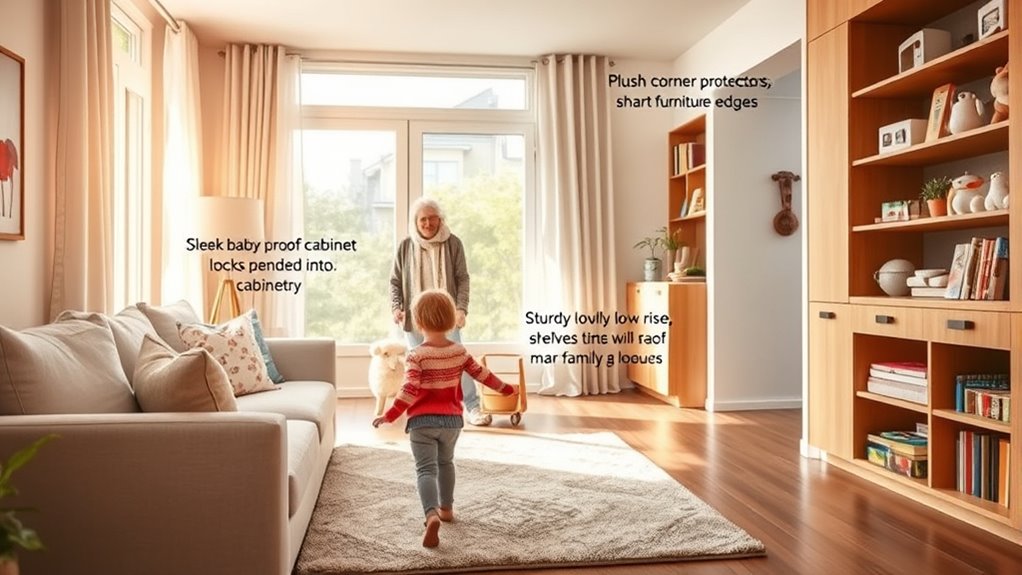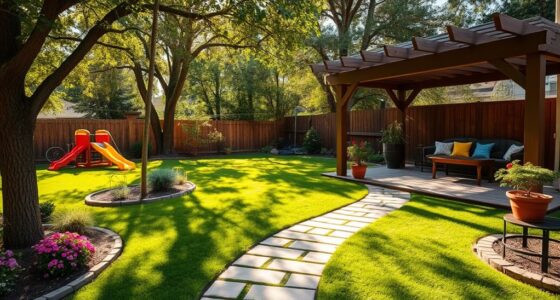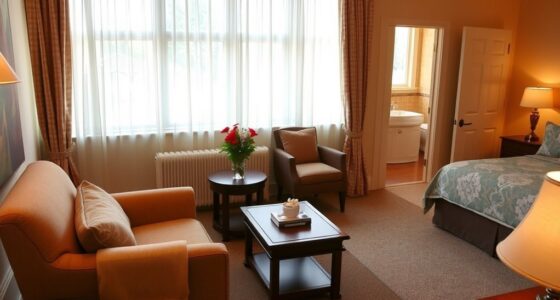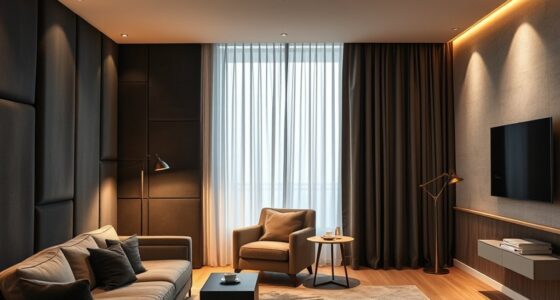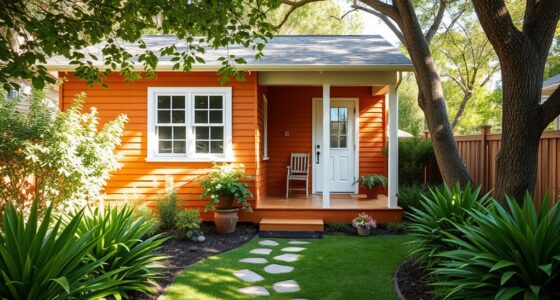To create a home that’s safe for all ages, you need to balance childproofing and senior-proofing measures. Childproofing focuses on securing furniture, covering outlets, and removing small or sharp objects, while senior-proofing emphasizes grab bars, non-slip surfaces, and accessible design. Both approaches aim to prevent falls and injuries but target different needs. If you explore further, you’ll discover how to combine these strategies seamlessly for a truly versatile, hazard-free space.
Key Takeaways
- Both focus on safety, but childproofing emphasizes preventing injuries from curiosity, while senior-proofing enhances accessibility and fall prevention.
- Overlapping safety measures include slip-resistant surfaces, secure rugs, and clutter removal for all age groups.
- Design features like grab bars, wide doorways, and soft corner protectors support both children and seniors.
- Safety solutions should blend seamlessly with aesthetics, supporting independence and ease of use for everyone.
- Staying informed on safety standards ensures the home remains versatile and secure for all ages.
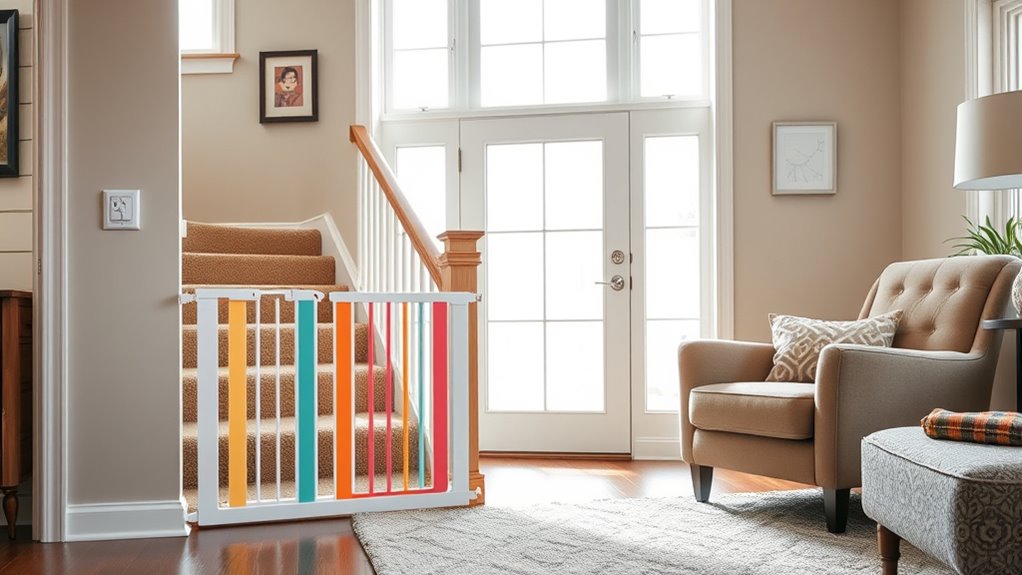
When it comes to making your home safe, understanding the differences between childproofing and senior-proofing is essential. Both aim to prevent accidents, but they focus on different needs and environments. For instance, incorporating regional flavors and traditions into your home’s design can create a more inviting atmosphere for all ages. For childproofing, you’re looking to create a nursery design that minimizes hazards for curious little ones. This means securing furniture to the wall, covering electrical outlets, and using safety gates to block stairways. You also want to store small objects, medicines, and sharp items out of reach. Nursery design isn’t just about aesthetics; it’s about safety. Soft corner protectors, window locks, and cabinet latches help prevent injuries and give you peace of mind as your child explores. When designing a nursery, think about the space’s layout and materials, choosing non-toxic paints and child-friendly fabrics to eliminate potential health risks. Additionally, selecting appropriate materials that are durable and easy to clean can help maintain a safe and hygienic environment for children. Being aware of current safety standards and innovations can also assist in integrating the latest protective features into your nursery. Moreover, staying informed about current safety standards and innovations can help you implement the latest protective features effectively.
On the other hand, senior-proofing is about making your home accessible and safe for elderly residents or visitors with mobility challenges. Elderly accessibility involves installing grab bars in bathrooms, ensuring doorways are wide enough for walkers or wheelchairs, and adding non-slip flooring in high-risk areas. It’s about reducing fall hazards and making everyday tasks easier. You might also consider adjusting kitchen counters to a comfortable height or placing frequently used items within easy reach to prevent unnecessary bending or stretching. For seniors, safety isn’t just about preventing falls; it’s about maintaining independence. You want a home that supports their needs without making them feel confined or stigmatized. Proper lighting and clear pathways are also crucial in creating a secure environment for seniors. Incorporating smart home technology can further enhance safety and convenience for elderly residents, offering remote monitoring and automated safety features. These technologies can also help caregivers respond swiftly to emergencies, increasing overall safety.
While both approaches focus on safety, they address different priorities. Childproofing emphasizes preventing injuries caused by curiosity and small objects, whereas senior-proofing centers on mobility, balance, and ease of use. However, some features overlap, like securing rugs to prevent slips or removing clutter to reduce tripping hazards. A well-thought-out home considers both perspectives so that it’s safe for children and seniors alike. Remember, designing for different age groups isn’t about sacrificing style—it’s about creating a versatile space that adapts to everyone’s needs. Whether it’s a nursery or an accessible bathroom upgrade, safety features should blend seamlessly with your home’s aesthetics, ensuring that everyone can enjoy a secure, comfortable environment.
Frequently Asked Questions
How Can I Balance Safety With Aesthetic Appeal in Home Modifications?
Balancing safety with aesthetic appeal means choosing decorative fixtures that blend style and function. You can opt for sleek, modern safety devices like hidden outlets and unobtrusive grab bars that provide stylish safety. Incorporate soft, neutral colors and elegant designs to keep your home visually appealing while ensuring safety. Prioritize stylish safety solutions that complement your decor, making your space both beautiful and secure without sacrificing either aspect.
What Are Cost-Effective Strategies for Multi-Generational Home Safety?
Imagine your home as a safe haven, where everyone feels secure. To achieve this cost-effectively, focus on cost-saving measures like securing rugs and installing grab bars with DIY safety tips. Use simple, inexpensive fixes like furniture corner protectors and outlet covers. Prioritize high-traffic areas and common hazards, making small adjustments that add up, creating an inclusive space that’s safe for all ages without breaking the bank.
How Often Should Safety Assessments Be Conducted in a Shared Home?
You should conduct safety assessments in your shared home at least every six months. During these checks, review medication management to prevent accidental misuse and ensure emergency preparedness plans are up to date. Regular assessments help identify hazards early, allowing you to make necessary adjustments to keep everyone safe. Staying proactive ensures your home remains secure for all ages, addressing evolving needs and maintaining a safe environment for children and seniors alike.
Are There Universal Safety Features Suitable for All Ages?
You should look for universal safety features that suit all ages, like universal design principles and adaptable features. These include lever handles instead of knobs, non-slip flooring, and good lighting. By incorporating adaptable features, your home becomes safer and more accessible for everyone, regardless of age or ability. This approach guarantees your space is inclusive, reducing hazards while maintaining convenience and comfort for all household members.
How Can Technology Enhance Safety for Children and Seniors Simultaneously?
Think of your home as a safe harbor, where technology acts as vigilant lighthouse. Smart sensors detect movement, alerting you to potential hazards for kids and seniors alike. Voice assistants provide instant guidance, whether reminding about medication or warning of obstacles. Together, these tools create a seamless safety net, ensuring everyone feels protected and cared for, regardless of their age or mobility. Technology truly bridges the gap between generations.
Conclusion
Just as the Tower of Babel needed careful planning to prevent chaos, your home requires thoughtful childproofing and senior-proofing to guarantee everyone’s safety. By taking these proactive steps, you create a sanctuary where both the curious child and the wise senior can thrive without worry. Remember, a home that adapts to all ages isn’t just a space—it’s a haven, echoing the timeless wisdom of Solomon’s foresight and care.
